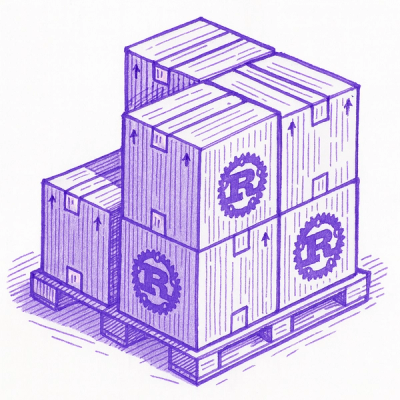
Security News
Knip Hits 500 Releases with v5.62.0, Improving TypeScript Config Detection and Plugin Integrations
Knip hits 500 releases with v5.62.0, refining TypeScript config detection and updating plugins as monthly npm downloads approach 12M.
react-zdog
Advanced tools

npm install zdog react-zdog
# or
yarn add zdog react-zdog

react-zdog is a declarative abstraction of zdog, a cute pseudo 3d-engine. Doing zdog in React allows you to break up your scene graph into declarative, re-usable components with clean, reactive semantics. Try a live demo here.
import ReactDOM from "react-dom";
import React from "react";
import { Illustration, Shape } from "react-zdog";
ReactDOM.render(
<Illustration zoom={8}>
<Shape stroke={20} color="lightblue" rotate={{ x: Math.PI }} />
</Illustration>,
document.getElementById("root")
);
The Illustration object is your portal into zdog. It forwards unreserved properties to the internal Zdog.Illustration instance. The component auto adjusts to re-size changes and fills out the wrapping relative/absolute parent.
<Illustration element="svg" /> // Can be either 'svg' or 'canvas'
element: Sets the graphics rendering DOM Element. Can be either 'svg' or 'canvas'. Default is "svg"frameloop: Determins the render loop behavior, Can be either 'always' or 'demand'. default is 'always'.pointerEvents: enables pointer events on zdog elements if set to true. Default is False.style: styles for main renderer dom elemeent container.onDragStart: callback on illustration's on drag start event listeneronDragMove: callback on illustration's on drag move event listeneronDragEnd: callback on illustration's on drag end event listenerAnd all the other props you will pass will be attached to illustration object. So any other properties or methods that you wanna set on illustration can be passed as prop as it is.
All hooks can only be used inside the Illustration element because they rely on context updates!
If you're running effects that need to get updated every frame, useRender gives you access to the render-loop.
import { useRender } from "react-zdog";
function Spin({ children }) {
const ref = useRef(undefined);
useRender((t) => (ref.current.rotate.y += 0.01));
return <Anchor ref={ref}>{children}</Anchor>;
}
Gives you access to the underlying state-model.
import { useZdog } from 'react-zdog'
function MyComponent() {
const {
illu, // The parent Zdog.Illustration object
scene, // The Zdog.Anchor object that's being used as the default scene
size, // Current canvas size
} = useZdog()
Gives you access to function that updates the one scene frame on each call. It is useful only if you're setting frameloop props on Illustration component as demand
function MyComponent() {
const invalidate = useInvalidate()
const boxRef = useRef()
const rotate = () => {
boxRef.current.rotate.x += 0.03;
boxRef.current.rotate.y += 0.03; //this will update underlying javascript object
invalidate() //But you need to call invalidate to render the changes on screen
}
return (
<Box
ref={boxRef}
{/* ...other props */}
/>
)}
React-zdog supports the Click, Pointer Move, Pointer Enter and Pointer Leave events on Zdog elemets.
To use pointer events just enable the pointer events by setting pointerEvents prop to true on Illustration component.
<Illustration pointerEvents={true} />
and use onClick, onPointerMove, onPointerEnter and OnPointerLeave on any zdog element.
const onClick = (e, ele) => {
//runs when user clicks on box
};
const onPointerMove = (e, ele) => {
//runs when user moves pointer over box
};
const onPointerEnter = (e, ele) => {
//runs when user's pointer enters the box
};
const onPointerLeave = (e, ele) => {
//runs when user's pointer leaves the box
};
return (
<Box
onClick={onClick}
onPointerMove={onPointerMove}
onPointerEnter={onPointerEnter}
onPointerLeave={onPointerLeave}
/>
);
import React, { useRef, useEffect } from 'react';
import { Illustration, useRender, useInvalidate, Box } from 'react-zdog';
// RotatingCube Component
const RotatingCube = () => {
const boxRef = useRef();
// Use the useRender hook to continuously update the rotation
useRender(() => {
if (boxRef.current) {
boxRef.current.rotate.x += 0.03;
boxRef.current.rotate.y += 0.03;
}
});
return (
<Box
ref={boxRef}
width={50}
height={50}
depth={50}
color="#E44"
leftFace="#4E4"
rightFace="#44E"
topFace="#EE4"
bottomFace="#4EE"
/>
);
};
// App Component
const App = () => {
return (
<Illustration zoom={4}>
<RotatingCube />
</Illustration>
);
};
export default App;
import React, { useRef, useState } from 'react';
import { Illustration, useRender, Box } from 'react-zdog';
// InteractiveCube Component
const InteractiveCube = () => {
const [isClicked, setIsClicked] = useState(false);
const colorsBeforeClick = {
main: "#E44",
left: "#4E4",
right: "#44E",
top: "#EE4",
bottom: "#4EE"
};
const colorsAfterClick = {
main: "#FF5733",
left: "#33FF57",
right: "#3357FF",
top: "#FF33A1",
bottom: "#A133FF"
};
const currentColors = isClicked ? colorsAfterClick : colorsBeforeClick;
const handleBoxClick = () => {
setIsClicked(!isClicked);
};
return (
<Box
width={50}
height={50}
depth={50}
color={currentColors.main}
leftFace={currentColors.left}
rightFace={currentColors.right}
topFace={currentColors.top}
bottomFace={currentColors.bottom}
onClick={handleBoxClick}
/>
);
};
// App Component
const App = () => {
return (
<Illustration pointerEvents={true} zoom={4}>
<InteractiveCube />
</Illustration>
);
};
export default App;
import React, { useRef, useEffect } from "react";
import { Illustration, useInvalidate, Box } from "react-zdog";
// RotatingCube Component
const RotatingCube = () => {
const boxRef = useRef();
const invalidate = useInvalidate();
useEffect(() => {
const animate = () => {
if (boxRef.current) {
boxRef.current.rotate.x += 0.03;
boxRef.current.rotate.y += 0.03;
invalidate(); // Manually trigger a render
}
};
const intervalId = setInterval(animate, 1000); // only renders the scene graph one a second instead of 60 times per second
return () => intervalId && clearInterval(intervalId);
}, [invalidate]);
return (
<Box
ref={boxRef}
width={50}
height={50}
depth={50}
color="#E44"
leftFace="#4E4"
rightFace="#44E"
topFace="#EE4"
bottomFace="#4EE"
/>
);
};
// App Component
const App = () => {
return (
<Illustration zoom={4} frameloop="demand">
<RotatingCube />
</Illustration>
);
};
export default App;
Pull requests are welcome. For major changes, please open an issue first to discuss what you would like to change.
FAQs
React-fiber renderer for zdog
The npm package react-zdog receives a total of 117,922 weekly downloads. As such, react-zdog popularity was classified as popular.
We found that react-zdog demonstrated a not healthy version release cadence and project activity because the last version was released a year ago. It has 2 open source maintainers collaborating on the project.
Did you know?

Socket for GitHub automatically highlights issues in each pull request and monitors the health of all your open source dependencies. Discover the contents of your packages and block harmful activity before you install or update your dependencies.

Security News
Knip hits 500 releases with v5.62.0, refining TypeScript config detection and updating plugins as monthly npm downloads approach 12M.

Security News
The EU Cyber Resilience Act is prompting compliance requests that open source maintainers may not be obligated or equipped to handle.

Security News
Crates.io adds Trusted Publishing support, enabling secure GitHub Actions-based crate releases without long-lived API tokens.